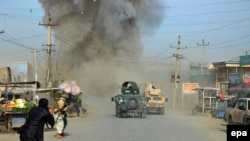Afghan officials have confirmed the presence of Islamic State (IS) militants in the northeastern province of Kunduz, which borders Tajikistan and is in close proximity to Uzbekistan.
Provincial Governor Mohammad Omar Safi told Radio Free Afghanistan on March 3 that Kunduz residents have spotted IS militants in various districts on Afghanistan's border with Tajikistan.
"The residents of some parts of Char Dara, Imam Sahib and Archi districts have spotted IS militants," he said. "They have seen groups of 50 to 70 masked militants in these areas. They are dressed in black and are keen on keeping a distance from local residents."
Kunduz officials are now asking security officials in the capital Kabul to help them in dealing with this newly emerging threat.
Najib Danish, a spokesman for the Interior Ministry in Kabul, told Radio Free Afghanistan that Afghan security forces are preparing for a new offensive in Kunduz.
"Our objectives are clear. We will act against any group or faction that threatens the security of our citizens," he said. "We will go after terrorist networks including Daesh (IS) militants. We are designing specific plans for parts of Kunduz. You will soon see a major offensive there."
Kunduz is the first Afghan province bordering Central Asia where IS is reported to have emerged.
According to the Kabul-based Afghanistan Analysts Network (AAN), the IS presence in Kunduz was inspired and possibly guided by a Syria-based Kunduzi fighter.
"Zia Abdul Haq (aka Abu Yusef), a 33-year-old Tajik, was one of the relatively early Afghans to join IS," a recent AAN report said. "He left his home in Australia, where he had become a citizen, for Syria and was killed on 23 October 2014."
The AAN report, however, noted that his group was disbanded by security officials, according to Afghan spy chief Rahmatullah Nabil.
Afghan observers say the hard-line Islamist group, which now controls large swaths of Iraq and Syria, might be positioning itself to expand into Central Asia.
A sizeable number of Central Asian militant factions previously allied with the Afghan and Pakistani Taliban has now reportedly joined IS, and their fighters are active on various fronts in Iraq and Syria. In recent years, the Islamic Movement of Uzbekistan (IMU) was trying to carve a sanctuary in the region to expand into its Central Asian homeland.
The IMU has been based in Pakistan's northwestern tribal areas along its border with Afghanistan after being pushed out of its Afghan bases following the demise of the Taliban regime in 2001. Kunduz served as the main IMU base in the 1990s.
Speaking at the Munich Security Conference last week, Afghan President Ashraf Ghani warned that Pakistan’s ongoing military operations in the North Waziristan tribal districts had displaced international terror networks from the country.
"The center of gravity has shifted to Afghanistan. Daesh (IS) is fast moving to stage four of its classic pattern, namely organizing, orienting, deciding and acting," he said. The threat of this ecology is global, but Afghanistan is the meeting ground of this global ecology. Lest we forget this and take our eyes elsewhere, there will be consequences."
His comments were backed by the commander of international forces in Afghanistan. U.S. General John Campbell told lawmakers in Washington last month that the emergence of IS there is a new development.
"We believe that the nascent Daesh presence in Afghanistan represents more of a rebranding of a few marginalized Taliban, but we're still taking this potential threat ― with its dangerous rhetoric and ideology ― very, very seriously," he said. "We're all driven to prevent Daesh from establishing a meaningful foothold in Central Asia."
The emergence of new threats has prompted Washington to even reconsider its Afghanistan plans. During a visit to the country late last month, U.S. Secretary of Defense Ashton Carter said Washington has reasons to consider slowing down the drawdown in Afghanistan.
In recent months, IS militants have showed their resilience by expanding their presence despite early losses. The purported head of IS in Afghanistan, Mullah Abdul Rauf Khadim, was killed in the southern province of Helmand in February. Earlier, in January, his forces fought pitched battles with the Taliban and terrorized locals.
Khadim, a former Taliban commander and inmate at the U.S. prison in Guantanamo Bay, showcased the potential of disgruntled Taliban elements to join more radical Islamist factions.
Masked fighters often dressed in black and carrying black IS flags have also emerged in the southeastern province of Logar and the southwestern province of Farah. Purported pamphlets from IS have threatened Shi'ite communities in Kabul.
fg/







